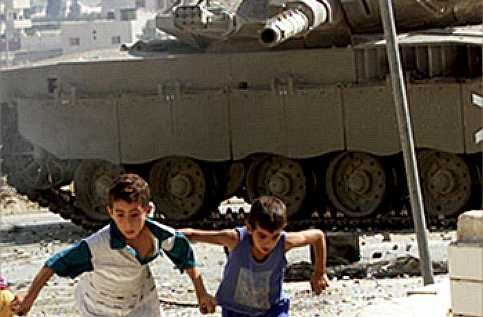Palestinian Center for Human Rights 11 December 2003

Photo: PCHR, 2003)
This week, Israeli occupying forces continued to violate the human rights of Palestinian civilians in the Occupied Palestinian Territories (OPTs). Throughout the week they conducted incursions into Palestinian areas; shot at Palestinian civilians, including children; indiscriminately shelled residential areas; demolished houses; and leveled agricultural land. 2 Palestinian children were killed by Israeli occupying forces in Rafah in the southern Gaza Strip and Qalandya refugee camp, north of Jerusalem. Israeli occupying forces also continued to impose a tight siege on the OPTs.
In violation of international human rights and humanitarian law, in particular the Geneva Convention Relative to the Protection of Civilian Persons in Time of War of 1949, Israeli forces continued to take retaliatory measures against the families of Palestinians Israel alleges have ordered, facilitated, or carried out attacks against Israeli targets. In this context, Israeli occupying forces destroyed a Palestinian house in Hebron.
Also in clear violation of international humanitarian law, Israeli occupying forces transferred 12 Palestinians from the West Bank to the Gaza Strip. 8 of the group were moved to the Gaza Strip on Thursday evening, 4 December 2003; the remaining 4 Palestinians were moved to the Gaza Strip on Friday morning, 5 December 2003. The transfers followed a ruling issued by the Israeli High Court on Thursday, 4 December 2003, approving the transfer orders issued against the 12 by Major General Moshe Kaplinski, GOC of the Central Command. Since 10 November 2003, 17 of the original group of 18 have been transferred to the Gaza Strip. The 18th detainee, Mustafa ‘Aabed, from Nablus, remains in detention at Erez military compound in the northern Gaza Strip. These transfers constitute a war crime as clarified in article 85 of the First Additional Protocol to the Geneva Conventions.
On Monday morning, 8 December 2003, Bashir Mohammed Ahmed ‘Owais, 27, from Balata refugee camp east of Nablus, died following reports of torture and medical negligence. ‘Owais was being held in custody by Israeli occupying forces at ‘Affoula Hospital in Israel at the time of his death.
Despite international criticism, including the recent UN General Assembly Resolution referring the case of the “separation wall” in the West Bank to the International Court of Justice, Israeli occupying forces continued with its construction. This week, construction continued on the part of the wall passing near the Jerusalem villages of ‘Anata, al-Sawahra al-Sharqia, ‘Eizariya and Abu Dis. Upon completion of this section, the villages will be divided into isolated cantons and approximately 2000 donums[1] of land in ‘Eizariya village will be annexed to “Ma’aleh Adumim” settlement. It will also isolate approximately 50 Palestinian houses from the rest of the village. In addition, for three days this week Israeli occupying forces closed the iron gate between Baqa al-Sharqia village, west of Tulkarm and its agricultural areas, denying Palestinian farmers access to these areas.
Israeli occupying forces have continued to impose severe restrictions on movement of Palestinian civilians in the Gaza Strip and the West Bank, including Jerusalem.
In the Gaza Strip, Israeli occupying forces continued to impose a strict siege on Palestinian communities and restrict the movement of Palestinian civilians. They also continued to enforce the closure of a number of main and branch roads in the Gaza Strip and Palestinian civilians continue to be subjected to humiliating and degrading treatment at Israeli military checkpoints and border crossings. The restrictions on movement and the fragmentation of the OPTs, through the erection of Israeli checkpoints and barriers, systematically violate Palestinian economic, social and cultural rights. Recently, Israeli occupying forces imposed further restrictions on the movement of Palestinian civilians between the north and south of the Gaza Strip. In the West Bank, Israeli occupying forces continued to impose a strict siege on Palestinian communities and restrict the movement of Palestinian civilians. They also continued to close permanent military checkpoints, erected temporary ones on main and branch roads and imposed curfews on a number of Palestinian communities.
In a step aimed at maintaining control over the Gaza Strip, Israeli occupying forces established a new military post and observation tower to the west of “Netzarim” settlement, south of Gaza City, and a new observation tower along the eastern border of the Gaza Strip. They also equipped another observation tower along the border with a camera. It is worth noting that there are approximately 65 Israeli military posts inside and along the borders of the Gaza Strip, with high observation towers that are often used to shell Palestinian residential areas. PCHR’s field workers reported that there is an Israeli military post every 2 kilometers along the border between the Gaza Strip and Israel.
To download the full report click here.